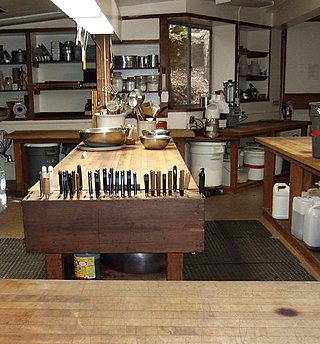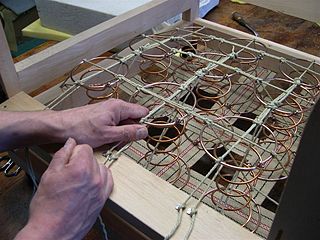
Boat building is the design and construction of boats and their systems. This includes at a minimum a hull, with propulsion, mechanical, navigation, safety and other systems as a craft requires.

A structural insulated panel, or structural insulating panel, (SIP), is a form of sandwich panel used in the construction industry.

Extrusion is a process used to create objects of a fixed cross-sectional profile by pushing material through a die of the desired cross-section. Its two main advantages over other manufacturing processes are its ability to create very complex cross-sections; and to work materials that are brittle, because the material encounters only compressive and shear stresses. It also creates excellent surface finish and gives considerable freedom of form in the design process.

A curtain wall is an exterior covering of a building in which the outer walls are non-structural, instead serving to protect the interior of the building from the elements. Because the curtain wall façade carries no structural load beyond its own dead load weight, it can be made of lightweight materials. The wall transfers lateral wind loads upon it to the main building structure through connections at floors or columns of the building.

Vinyl siding is plastic exterior siding for houses and small apartment buildings, used for decoration and weatherproofing, imitating wood clapboard, batten board and batten or shakes, and used instead of other materials such as aluminum or fiber cement siding. It is an engineered product, manufactured primarily from polyvinyl chloride (PVC) resin. In the UK and New Zealand a similar material is known as uPVC weatherboarding.

A window shutter is a solid and stable window covering usually consisting of a frame of vertical stiles and horizontal rails. Set within this frame can be louvers, solid panels, fabric, glass and almost any other item that can be mounted within a frame. Shutters may be employed for a variety of reasons, including controlling the amount of sunlight that enters a room, to provide privacy, security, to protect against weather or unwanted intrusion or damage and to enhance the aesthetics of a building.

Kitchen cabinets are the built-in furniture installed in many kitchens for storage of food, cooking equipment, and often silverware and dishes for table service. Appliances such as refrigerators, dishwashers, and ovens are often integrated into kitchen cabinetry. There are many options for cabinets available at present.

In furniture-making, the upholstery frame of a piece of furniture gives the structural support and determines the basic shape of the upholstered furniture. The frame may be a basic piece of wooden furniture prior to its being upholstered. Like a finished piece of furniture prior to the upholstering, the frame establishes the final quality, including its durability, and sets limits upon the final design, padding, cushioning, or cover.

A window screen is designed to cover the opening of a window. It is usually a mesh made of metal, fibreglass, plastic wire, or other pieces of plastic and stretched in a frame of wood or metal. It serves to keep leaves, debris, bugs, birds, and other animals from entering a building or a screened structure such as a porch, without blocking fresh air-flow.
Storm windows are windows that are mounted outside or inside of the main glass windows of a house. Storm windows exist in North America, but are uncommon in continental Europe, where double, triple or quadruple glazing is prevalent. Storm windows can be made of glass, rigid plastic panels, or flexible plastic sheets; and may be permanently or temporarily mounted. They function similarly to insulated glazing. The term may also refer to a small openable flap found in the side window on light aircraft.

A sash window or hung sash window is made of one or more movable panels, or "sashes". The individual sashes are traditionally paned windows, but can now contain an individual sheet of glass.

In architecture and construction, a sliding glass door is a type of sliding door made predominantly from glass, that is situated in an external wall to provide egress and light. The doors can give access to a backyard or patio while providing a pleasant view, and when not fully covered can be a source of passive daylighting. Like a window, when open it also provides fresh air and copious natural light. It is considered a single unit consisting of two or more panel sections, some or all being mobile to slide open. Another design, a wall-sized glass pocket door has one or more panels movable and sliding into wall pockets, completely disappearing for a 'wide open' indoor-outdoor room experience.

A screen door can refer to a hinged storm door or hinged screen door covering an exterior door, or a screened sliding door used with sliding glass doors. A screen door incorporates screen mesh to block birds, flying insects or airborne debris such as seeds or leaves from entering, and pets and small children from exiting interior spaces, while allowing for air, light, and views.
Glass fibre reinforced concrete (GFRC) is a type of fibre-reinforced concrete. The product is also known as glassfibre reinforced concrete or GRC in British English. Glass fibre concretes are mainly used in exterior building façade panels and as architectural precast concrete. Somewhat similar materials are fibre cement siding and cement boards.

Edge banding or edgebanding is the name of both a process and an associated narrow strip of material used to create durable and aesthetically pleasing trim edges during finish carpentry. Edge banding is used to cover the exposed sides of materials such as plywood, particle board, or MDF, increasing durability and giving the appearance of a solid or more valuable material.
A fabric structure is a structure made of fabric, with or without a structural frame made from the weaving of the fabric itself. The technology provides end users a variety of aesthetic free-form building designs. Custom-made structures are engineered and fabricated to meet worldwide structural, flame retardant, weather-resistant, and natural force requirements. Fabric structures are considered a sub-category of tensile structure.

Twin-wall plastic, specifically twin-wall polycarbonate, is an extruded multi-wall polymer product created for applications where its strength, thermally insulative properties, and moderate cost are ideal. Polycarbonate, which is most commonly formed through the reaction of Bisphenol A and Carbonyl Chloride, is an extremely versatile material. It is significantly lighter than glass, while managing to be stronger, more flexible, and more impact resistant. Twin-wall polycarbonate is used most commonly for green houses, where it can support itself in a structurally sound configuration, limit the amount of UV light due to its nominal translucence, and can withstand the rigors of daily abuse in an outdoor environment. The stagnant air in the cellular space between sheets provides insulation, and additional cell layers can be extruded to enhance insulative properties at the cost of light transmission.

Insulating glass (IG) consists of two or more glass window panes separated by a space to reduce heat transfer across a part of the building envelope. A window with insulating glass is commonly known as double glazing or a double-paned window, triple glazing or a triple-paned window, or quadruple glazing or a quadruple-paned window, depending upon how many panes of glass are used in its construction.
Extrusion is a plastic deformation process in which raw material (billet) is forced to flow by compression through the die opening of a smaller cross-section area. The extrusion process is divided in two basic types: direct extrusion and indirect extrusion. In direct extrusion the billet is pushed through the die with ram pressure, whereas in indirect extrusion a die moves relative to the container.

















